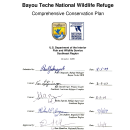What We Do
Wildlife conservation is at the heart of the National Wildlife Refuge System. It drives everything on U.S. Fish and Wildlife Service lands and waters managed within the refuge system, from the purposes for which a national wildlife refuge is established, to the recreational activities offered, to the resource management tools used. Using conservation best practices, the refuge system manages Service lands and waters to help ensure the survival of native wildlife species.
Management and Conservation
Refuge staff use a variety of resource-management techniques to maintain, recover or enhance plants and wildlife and the habitats they rely on.
Bear management
Bayou Teche contains important bear habitat which is managed to support the recovery of this species. We maintain forested habitat and canebrakes to provide food, cover, travel corridors, and den sites for Louisiana black bears. The old spoil banks and other elevated lands on the refuge and nearby woodland habitats are core habitats for bears. These areas supply summer and fall food supplies and winter denning sites. Bears use the spoil banks to travel within the swamp and to connect to ridges that extend into the marshes. The cypress-tupelo swamps provide spring and summer food resources and winter denning habitat in the rare remnant cypress trees. Seasonal closures of some areas protect denning habitat.
Invasive species management
Harmful, introduced species degrade, change, or displace native habitats and compete with indigenous plants and wildlife. Monitoring and control of these nuisance species is an integral part of refuge management. Species we control include feral hogs, nutria, salvinia, water hyacinth, and Chinese tallow.
Wood duck nest boxes
While visiting the refuge you may notice wood duck nesting boxes. With the loss of mature forest, artificial nesting cavities help support this species.
Administer oil and gas program
There are many plugged and abandoned wells throughout the refuge, with six major transmission pipelines traversing the refuge. We work with utilities to support access to their facilities and monitor decommissioned sites.
Our Projects and Research
Bayou Teche National Wildlife Refuge conserves bottomland hardwood forest habitat, which has been significantly diminished in the Mississippi River Delta over the last century. The refuge was specifically designated to conserve habitat for the Louisiana black bear.
Research
Refuge staff monitor and assess species health and distribution in collaboration with universities and government agencies. We are cooperating on studies of neotropical birds and amphibians, as well investigating treatments to control invasive species invasive species
An invasive species is any plant or animal that has spread or been introduced into a new area where they are, or could, cause harm to the environment, economy, or human, animal, or plant health. Their unwelcome presence can destroy ecosystems and cost millions of dollars.
Learn more about invasive species on the refuge.
Stewardship and Education
We work with Coastal Roots Coastal Roots Seedling Nursery Program which establishes wetland seedling nurseries at schools within the coastal zone of Louisiana. Students from 4th grade through high school in south Louisiana manage the nurseries. Students grow native plant seedlings and grass plugs that they will plant in a habitat restoration project. They oversee the growth cycle of the plants, from seed germination to the planting of the seedlings in habitat restoration programs during the fall semester. These students help plant trees and restore former sugar cane fields to forested habitat and cane brakes for food and shelter for bears.
Law Enforcement
The U.S. Fish and Wildlife Service maintains a law enforcement presence on National Wildlife Refuge lands for wildlife and public safety. Our refuge law enforcement officers protect fish, wildlife, plants and other natural, cultural and historic resources by fostering understanding and instilling in the visiting public an appreciation of refuge resources, laws, and regulations.





